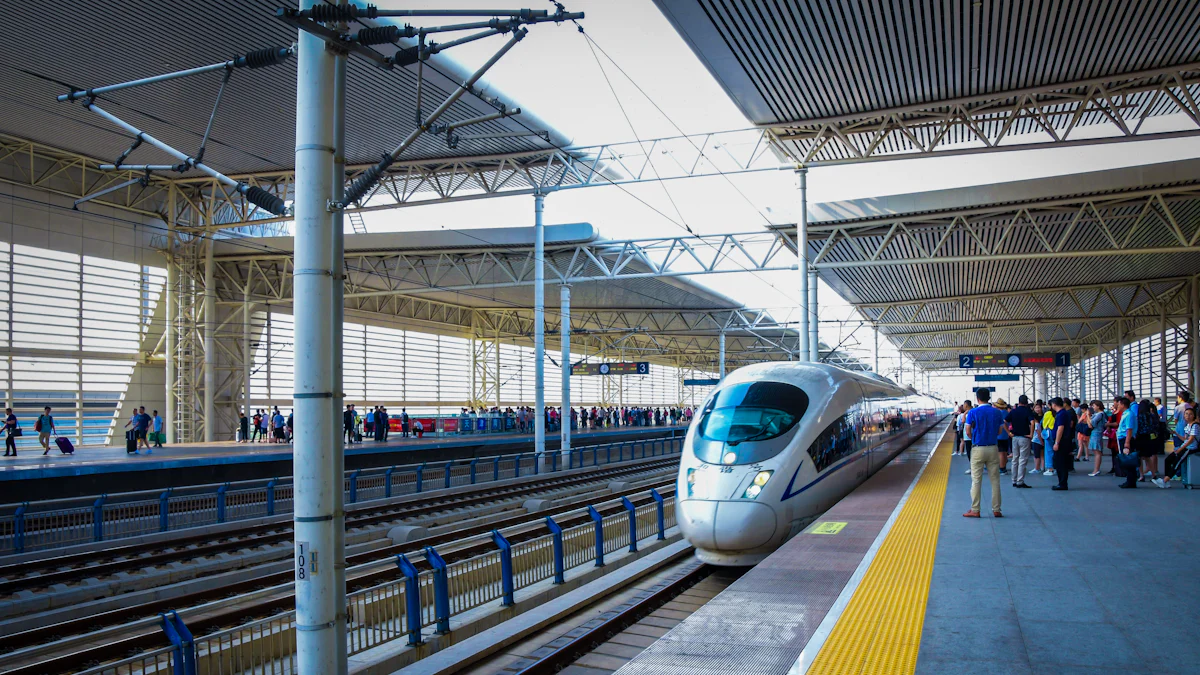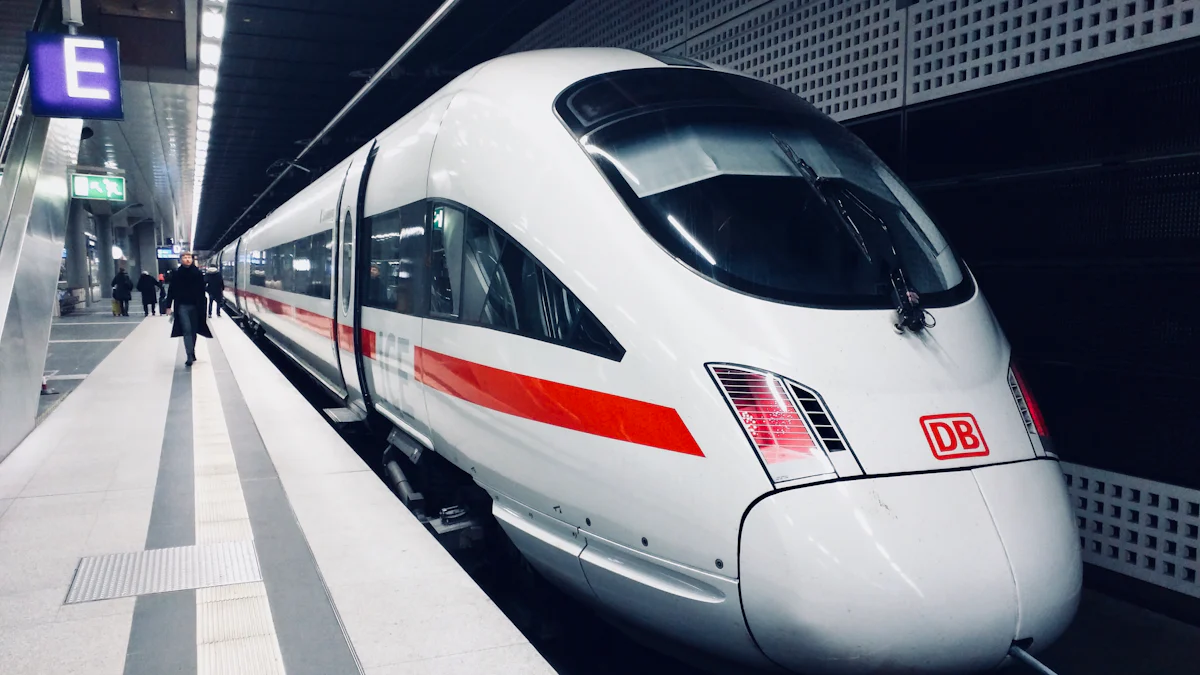2024 Forecast: The Impact of China-Europe Railway on Global Rail Transport

The China-Europe Railway has revolutionized global rail transport, and the 2024 forecast highlights its significant impact. Connecting over 30 countries in Eurasia, the railway facilitates the movement of goods across vast distances. The annual number of freight train services surged from 1,702 to over 17,000, with an average annual growth rate of 39.5%. In May 2024, the railway recorded the highest monthly transport volume, moving 186,000 twenty-foot equivalent units of cargo. This extensive network supports cross-border transportation and regional circulation, making it a critical component of global trade.
2024 Forecast: Historical Context
Development of the China-Europe Railway
Initial Conception and Planning
The China-Europe Railway began as a visionary project aimed at enhancing trade dynamics between Asia and Europe. The first regular rail freight service between China and Europe launched in 2008. This initiative offered an alternative to traditional maritime shipping routes. The initial conception focused on creating a faster and more cost-effective transportation method. The planning phase involved extensive collaboration between multiple countries. Each nation contributed to the development of the railway infrastructure.
Key Milestones and Construction Phases
The construction of the China-Europe Railway saw several key milestones. The completion of the first route marked a significant achievement. Subsequent phases included the expansion of the network to cover more cities. By 2022, the railway connected over 223 cities in Europe and more than 100 in Asia. The China-Europe Railway Express played a crucial role in transforming cross-border logistics. The project facilitated economic and trade exchanges on an unprecedented scale.
Historical Trade Routes and Their Evolution
Silk Road and Its Modern Revival
The ancient Silk Road served as a vital trade route between Asia and Europe. This historic path enabled the exchange of goods, culture, and ideas. The modern revival of the Silk Road came through the China-Europe Railway. This contemporary version retained the essence of the ancient route. The railway provided a more efficient and reliable means of transport. The China-Europe Railway Express significantly increased trade volumes. Trade between China and Europe grew from 4 trillion yuan in 2013 to 7.42 trillion yuan in 2022.
Comparison with Other Major Trade Routes
The China-Europe Railway stands out when compared to other major trade routes. Maritime shipping routes have traditionally dominated global trade. However, the railway offers several advantages. Rail transport is faster and cheaper than sea and air transport. The extensive network covers over 30 countries in Eurasia. The annual volume of over 10,000 standard containers underscores the railway's capacity. The China-Europe Railway has reshaped global trade dynamics. The railway's impact on logistics efficiency cannot be overstated.
2024 Forecast: Current Trends and Statistics

Volume of Goods Transported
Major Commodities and Their Origins/Destinations
The China-Europe Railway transports a diverse range of commodities. Electronics, machinery, and automotive parts dominate the cargo. These goods primarily originate from industrial hubs in China. Major destinations include Germany, Poland, and the Netherlands. Agricultural products and textiles also form a significant portion of the transported goods. The railway's extensive network supports efficient movement across Eurasia.
Year-on-Year Growth and Projections
The China-Europe Railway has experienced remarkable growth. The annual number of trips surged from 1,702 in 2016 to over 17,000 by 2024. This represents an average annual growth rate of 39.5%. The volume of transported goods increased by 44% in the first quarter of 2024 compared to the previous year. Projections indicate continued expansion. The market size is expected to reach USD 12.70 billion in 2024 and grow to USD 40.30 billion by 2029. The railway's capacity and efficiency improvements drive this growth.
Economic Impact
Cost Efficiency and Time Savings
The China-Europe Railway offers significant cost efficiency. Rail transport is cheaper than air transport and faster than sea transport. The railway reduces transportation costs by up to 50% compared to air freight. The "fast customs clearance" system cuts customs times by 20%. This efficiency translates into substantial time savings. Goods reach European markets in 15-18 days, compared to 30-40 days by sea. The railway's reliability enhances supply chain management.
Influence on Regional Economies
The China-Europe Railway positively impacts regional economies. The railway facilitates trade between China and Europe, boosting economic exchanges. The rail network connects over 223 cities in Europe and more than 100 in Asia. This connectivity supports regional circulation and cross-border transportation. The railway's expansion plans include new routes and technological advancements. These developments will further enhance its performance. The China-Europe Railway strengthens global supply chains and fosters economic growth.
2024 Forecast: Logistical and Operational Changes
Infrastructure Developments
Upgrades to Rail Networks
The China-Europe Railway has undergone significant upgrades to enhance its infrastructure. The rail networks now feature advanced signaling systems that improve safety and efficiency. Modernization efforts include the installation of high-speed tracks, which reduce transit times. These upgrades ensure that the railway can handle increased freight volumes. Enhanced rail networks also support the transportation of a diverse range of goods.
Technological Innovations
Technological innovations play a crucial role in the 2024 forecast for the China-Europe Railway. The integration of AI and big data analytics optimizes supply chain management. Real-time monitoring systems track temperature and humidity levels during transit. These technologies ensure the safe transport of perishable goods. The railway also employs intelligent prediction models for dynamic ETA. This innovation improves scheduling accuracy and reduces delays.
Challenges and Solutions
Border and Customs Issues
Border and customs issues present challenges for the China-Europe Railway. Different countries have varying customs regulations, which complicates the clearance process. The railway addresses these challenges through strategic partnerships with major rail platforms. These partnerships facilitate fast customs clearance modes. The "fast customs clearance" system reduces processing times by 20%. This improvement enhances the overall efficiency of the railway.
Environmental and Sustainability Concerns
Environmental and sustainability concerns are critical in the 2024 forecast for the China-Europe Railway. Rail transport offers a more eco-friendly alternative to air and sea transport. The railway reduces carbon emissions by an estimated 30% compared to air freight. This reduction aligns with global sustainability goals. The railway also promotes the use of 53-foot SOC containers, which optimize space and reduce waste. These efforts contribute to a more sustainable global supply chain.
2024 Forecast: Future Prospects and Challenges

Expansion Plans
New Routes and Connections
The China-Europe Railway plans to expand its network significantly in the 2024 forecast. New routes will connect additional cities in Europe and Asia. These connections aim to enhance trade links and improve logistical efficiency. The railway will introduce routes that bypass congested areas, reducing transit times. This expansion will also include the development of secondary hubs. These hubs will facilitate smoother transshipment processes.
Potential Market Opportunities
The 2024 forecast identifies several market opportunities for the China-Europe Railway. Emerging markets in Eastern Europe and Central Asia present significant potential. These regions show increasing demand for efficient freight transport solutions. The railway will also target high-value commodities. Electronics, machinery, and automotive parts will remain key focus areas. The transport of perishable goods will see improvements through advanced monitoring systems. This diversification will boost the railway's market share.
Geopolitical and Economic Factors
Trade Policies and Agreements
Trade policies and agreements will play a crucial role in the 2024 forecast. Bilateral and multilateral agreements will facilitate smoother customs processes. These agreements will reduce tariffs and non-tariff barriers. The China-Europe Railway will benefit from enhanced trade relations between China and Europe. Government support will also provide subsidies and incentives. These measures will lower transportation costs and increase competitiveness.
Impact of Global Economic Trends
Global economic trends will influence the 2024 forecast for the China-Europe Railway. Economic growth in China and Europe will drive demand for freight services. The railway will see increased volumes of goods transported. Technological advancements will further optimize supply chain management. AI and big data analytics will enhance predictive capabilities. These technologies will improve scheduling accuracy and reduce delays. The railway will also contribute to global sustainability goals. Rail transport offers a more eco-friendly alternative to air and sea freight.
The China-Europe Railway has reshaped global rail transport through significant advancements. Key developments include increased freight volumes, enhanced infrastructure, and technological innovations. The railway's expansion plans and strategic partnerships promise further growth. Emerging technologies will optimize supply chain management. The railway will play a crucial role in global trade.
The future looks promising for the China-Europe Railway. Overcoming current challenges will pave the way for continued growth. Readers should consider the railway's potential impact on global logistics. Reflect on how this evolving network could influence future trade dynamics.
See Also
Revealing the Latest in Sea Freight Logistics for 2024
Analyzing the Future of Less Than Truckload Freight
Understanding the Influence of Logistics Risk Trends
